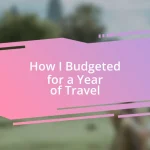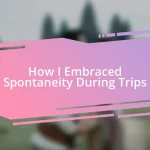Key takeaways:
- Embrace non-verbal communication, as gestures and body language can effectively bridge language gaps and foster connections.
- Learning basic local phrases and cultural norms can significantly enhance travel experiences and help build rapport with locals.
- Utilize translation apps wisely, being mindful of their limitations, and approach conversations with confidence and openness to overcome language barriers.

Understanding Language Barriers
Language barriers can sometimes feel like towering walls in a foreign land. I remember the first time I found myself trying to order dinner in a small Italian café. The menu was entirely in Italian, and my feeble attempts at pronunciation only seemed to confuse the waiter more. Have you ever felt that wave of anxiety when communication falters? It’s daunting, but those moments can also spark creativity.
I’ve learned that body language can bridge gaps when words fail. During a trip to Japan, I was lost and, rather than panicking, I simply pointed at a map while smiling and gesturing. The warmth of my enthusiasm was met with the locals’ smiles as they helped guide me. Those shared moments reminded me that communication goes beyond words.
Navigating language barriers often teaches us patience and empathy. It’s fascinating how a simple nod or a friendly wave can convey so much. Have you noticed how much we rely on tone and expression? When I finally made a connection through gestures, it not only eased my travel experience but created bonds that transcended language itself.

Preparing for Travel Challenges
Preparing for travel presents its own set of challenges, particularly when it involves language barriers. I recall preparing for a trip to Spain, where I made it a point to learn essential phrases. This not only minimized confusion but also made the locals more receptive. Have you ever felt the joy of connecting with someone simply by mastering a few words in their language? It’s a rewarding feeling that can enhance your travel experience immensely.
I also believe that familiarizing yourself with cultural contexts can alleviate misunderstandings. For example, in Greece, I learned that polite gestures matter – a simple nod or smile can go a long way. I remember feeling a sense of relief each time I used “parakalo” (please) and “efharisto” (thank you). Those little acknowledgments helped create a bond with the locals, and suddenly, language barriers felt a lot softer.
Finally, using technology can be a game-changer. Before one trip, I downloaded a translation app on my phone. One evening in a crowded market, I used it to communicate with a vendor about an unfamiliar spice. The moment he realized I was making an effort, his face lit up, and I felt like I was in on a special secret. Embracing these travel challenges can transform your journey into a rich tapestry of connections.
| Challenge | Preparation Strategy |
|---|---|
| Language Barrier | Learn key phrases |
| Cultural Misunderstanding | Study gestures and norms |
| Communication Gap | Utilize translation apps |

Learning Basic Local Phrases
Learning the local language can feel intimidating, but I’ve found that diving into basic phrases is like unlocking a door to an entire culture. On a trip to Mexico, I made it a priority to learn simple greetings and polite expressions. When I confidently said “Hola” and “Gracias,” I noticed locals smile back with warmth. That small investment in language created an immediate connection that turned strangers into friends. It’s amazing how just a few words can transform a travel experience.
Here’s a quick list of fundamental phrases I recommend practicing before any trip:
- Hello (Hola)
- Thank you (Gracias)
- Please (Por favor)
- Excuse me (Perdón)
- Do you speak English? (¿Habla inglés?)
In my experience, these expressions helped me navigate everything from ordering food to asking for directions, proving that knowledge of basic phrases can truly enhance one’s travels.

Using Translation Apps Effectively
Using translation apps effectively can truly ease the stress of traveling in a foreign country. I remember standing in a bustling Vietnamese street market, feeling a mixture of excitement and anxiety. I pulled out my translation app and typed “How much for this?” The stall owner quickly quoted a price in rapid Vietnamese, but thanks to the app, I could respond in kind, bridging that gap in communication. That moment was electrifying; it made me feel empowered and part of the local rhythm.
One of my favorite features in these apps is the voice translation option. I tried it during a night out in Barcelona when a local wanted to share their favorite tapas recommendations. I spoke into the app, and hearing my words transformed into Spanish felt surreal. I can still recall how their eyes widened with surprise and appreciation. It reminded me that while technology can be daunting, it can also foster genuine interactions.
But I’ve also learned to be mindful of the limitations of translation apps. I once relied on one to translate a complex menu in Morocco, only to discover it misinterpreted a dish. What I thought was chicken turned out to be an entirely different meat! That experience taught me the value of cross-referencing with pictures or asking for clarification. Have you ever faced an unexpected twist like that while traveling? Trust me, it’s always best to approach any language tool with curiosity and a sprinkle of caution.

Communicating Non-verbally
When language fails, body language often steps in to save the day. I recall a moment in Japan where I desperately needed to ask for directions but couldn’t understand a word of Japanese. Instead of feeling defeated, I pointed to my map, gestured toward the direction I wanted to go, and smiled. The shopkeeper responded with animated hand signals, and before I knew it, we were drawing little sketches on the counter to map out my route. Isn’t it fascinating how a simple gesture can lead to a memorable interaction?
Another time, I found myself in a small Italian town, trying to order dinner. The waiter spoke no English, and I barely knew a few food-related phrases. Instead of stumbling over words, I pointed to dishes on nearby tables while making exaggerated “mmm” sounds to express my interest. As I savored each bite, I realized that the shared joy of food transcended language barriers. It made me wonder—how often do we underestimate the power of our non-verbal cues?
Facial expressions can also play a critical role in communication. On a chaotic bus ride in Brazil, overwhelmed by the whirlwind of Portuguese chatter, I caught the eye of a fellow passenger. After exchanging a few smiles and eyebrow raises, we formed an unspoken camaraderie, united in our mutual confusion and laughter. That experience showed me that even during moments of miscommunication, a genuine smile is universal. I often find myself reflecting—how much can we convey without saying a word?

Building Confidence in Conversations
I remember the first time I tried striking up a conversation with someone who spoke little English. It was in a small café in Paris, and I felt a knot in my stomach as I approached the barista. Mustering all my courage, I smiled and attempted to ask for a coffee in broken French. To my surprise, she laughed warmly and guided me through the ordering process. That small victory was a game-changer, boosting my confidence to communicate more freely.
Over time, I’ve realized that confidence in conversation often comes from embracing vulnerability. When I traveled to Thailand, I joined a group of locals for a cooking class. Even though my Thai was limited, I enthusiastically shared what I could. I vividly recall how their encouraging nods and laughter made me feel at ease, turning each blunder into a shared joke. Can you imagine how liberating it feels to let go of perfection and simply enjoy the exchange?
Sometimes, the most awkward moments lead to the best connections. I was in a bustling market in Istanbul, trying to barter for a beautiful rug. My attempts to speak Turkish flopped miserably, and a few giggles were shared at my expense. However, instead of feeling embarrassed, I allowed myself to lean into the moment. We ended up chatting, showcasing textiles, and sharing stories about our cultures, proving that a little laughter can turn language barriers into bridges of understanding. Have you ever felt that buzz of excitement when overcoming an unexpected hurdle?

Overcoming Cultural Misunderstandings
Disentangling cultural misunderstandings can often feel like navigating a maze without a map. I once found myself in an Argentinian market, attempting to discuss the origins of a handmade necklace. As I enthusiastically described my own interpretations of their cultural art, the artisan’s bewildered expression revealed just how lost in translation I was. It struck me then—how crucial it is to check if we are truly being understood rather than assuming our message has landed smoothly. Have you ever had that moment of realization when your excitement simply complicates things?
On another occasion, during a modest dinner gathering in Morocco, I learned the importance of context in communication. While I shared my perspective on a dish, my comments were met with silence. I quickly realized that I had unwittingly criticized a cherished family recipe! In that moment, I felt the weight of my words and the need to approach such discussions with greater cultural sensitivity. Reflecting on it later, I understood how vital it is to respect traditions, and I now often refrain from commenting until I fully grasp the cultural significance behind them. How often do we forget the stories behind the words?
Sometimes, it’s the shared experience that turns misconceptions on their head. While strolling through a village in Greece, I accidentally knocked over a stack of precious pottery. My initial horror transformed into laughter as the locals rushed over, not to scold, but to help me gather the pieces. Their infectious laughter taught me something beautiful—when we engage with openness and humility, misunderstandings can pave the way for connection. Isn’t it remarkable how a shared mishap can unite us all?














